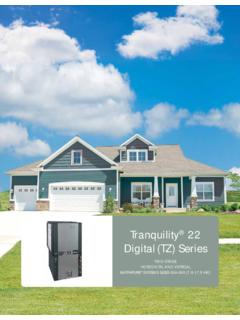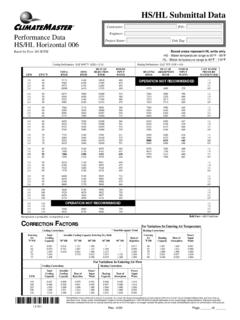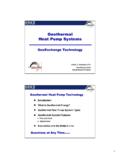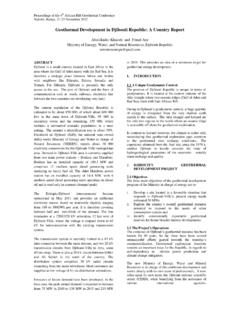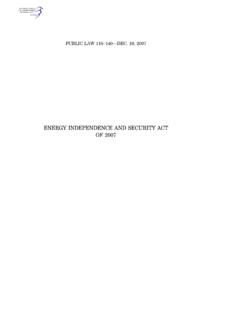Transcription of GUIDE TO FEDERAL TAX INCENTIVES FOR …
1 GUIDE TO. FEDERAL TAX INCENTIVES FOR. RESIDENTIAL geothermal HEAT PUMPS. CLIMATEMASTER geothermal HEATING AND COOLING. DECLARE YOUR PERSONAL energy INDEPENDENCE. Highlights FEDERAL Income Tax Credit: Eligibility: Tax credit equal to 30% of total system cost Home must be located in the (exceptions apply - see IRS guidelines for more Does not have to be your main home details) Includes houses, apartments, condos, mobile homes No limit to the maximum credit amount geothermal heat pump must be energy Star . Can be used to offset AMT tax qualified Can be used in more than one year Installed between 1/1/2008 and 12/31/2016.
2 Can be combined with solar and wind tax credits Can be combined with energy efficiency upgrade credits Residential energy -Efficient Property Credit In October 2008, geothermal heat pumps were added to section 25D of the Internal Revenue Code, which provides a 30% tax credit for spending on qualified property placed in service through the end of 2016. Eligible geothermal Heat Pump Property The tax credit may be claimed for spending on qualified geothermal heat pump property installed in connection with a new or existing dwelling unit located in the United States and used as a residence by the taxpayer.
3 It does not have to be the primary residence. The term qualified geothermal heat pump property means any equipment which . (i) uses the ground or ground water as a thermal energy source to heat the dwelling unit or as a thermal energy sink to cool the dwelling unit, and (ii) meets the requirements of the energy Star program which are in effect at the time that the equipment is installed. Spending for labor costs properly allocable to the installation of the geothermal heat pump property and for any associated piping, wiring, and interconnecting ducting are included.
4 Excluded Property The credit cannot be claimed on spending for equipment used solely to heat a swimming pool or hot tub, or on previously used equipment. Placed in Service Requirement The credit can only be claimed on spending for property that is placed in service during the period from 2008 through the end of 2016. In general, property is considered to be placed in service when the original installation is completed. However, if the geothermal heat pump property is part of the construction or reconstruction of a house, it is considered to be placed in service when the taxpayer takes up residence in the new or renovated house.
5 Tax Credit Amount and Maximum Cap An individual can claim a tax credit equal to 30% of spending on qualified geothermal heat pump property. For property placed in service after January 1, 2009, there is no limit on the amount of the tax credit that can be claimed. The tax credit can be used to offset both regular income taxes and alternative minimum taxes (AMT). If the tax credit exceeds the income tax liability, the remaining balance can be carried forward into future years. Cooperatives and Condominiums A corporation usually owns cooperative apartment buildings, and the residents are shareholders in the corporation.
6 If the corporation spends money on installing qualified geothermal heat pump property, each shareholder is allowed to claim a tax credit on his or her share of the spending. Owners of condominiums contribute to the upkeep of the condominiums by paying money to a condominium management association. Where such a management association spends money on installing qualified geothermal heat pump property, each member of the association can claim a tax credit on his or her share of that spending. However, the association must qualify as a homeowners' association under section 528(c)(1).
7 Of the tax code, and substantially all of the units in the condominium project must be used as residences. Effect on the Tax Basis on a House Amounts that are spent on improvements are added to the tax basis of the house. A higher tax basis generally means there is a smaller taxable gain when a house is later sold. Spending on geothermal heat pump property adds to the tax basis, but must be reduced by the amount of the tax credit received. Business Use If a dwelling unit serves a dual purpose, such as for a home office in the dwelling, the spending may have to be allocated between residential and business use.
8 If the portion considered residential spending is at least 80%, then all the spending qualifies for the residential credit. There is a 10% tax credit available for business use of geothermal heat pump property, and 5-year MACRS accelerated depreciation. Claiming the Credit IRS Form 5695 is used to claim the Residential energy Efficient Property Credit Residential Credit Examples Existing Home Example 2008 Deposit with 2009 Completion The taxpayers spent $12,000 to install a geothermal heat pump system in their existing home. They paid an initial deposit of $5000 in 2008 and the balance in 2009 when the system was completed.
9 2009 Tax Credit: $12,000 x 30% = $3,600. The deposit had no effect on the residential credit, which is entirely determined on the basis of the placed in service date. Major Renovation Example 2008 System Completion with 2009 Occupancy The taxpayers spent $30,000 to install a geothermal heat pump system in a home they are renovating. They paid for the geothermal heat pump system upon its completion in 2008, but did not move into the home until 2009. 2009 Tax Credit: $30,000 x 30% = $9,000. Even though the geothermal system was completed and paid for in 2008, it is considered to have been placed in service when the taxpayers moved into their home in 2009.
10 New Home Example The taxpayers contract to build a new home in 2009. Their builder spent $18,000 to install a geothermal heat pump system. They move into the home in March, 2010. 2010 Tax Credit: $18,000 x 30% = $5,400. New Condominium Example The taxpayers move into a new condominium in 2009. The condominium developer spent $450,000 to install a geothermal heat pump system in the 30 unit condominium structure. 2009 Tax Credit: $15,000 ($450,000 / 30) x 30% = $4,500. The developer allocates the proportionate geothermal heat pump system costs to each condominium purchaser.

